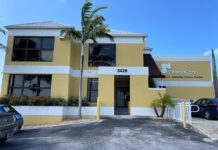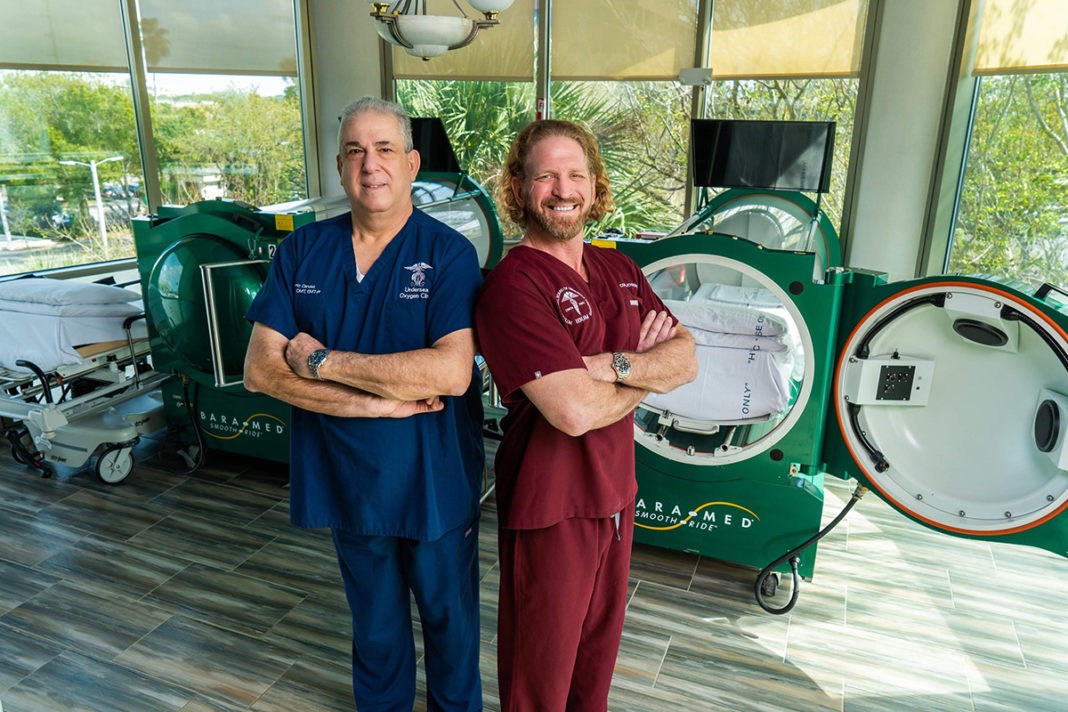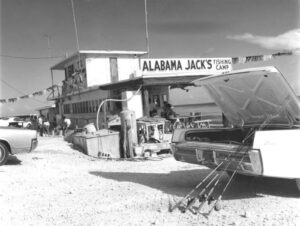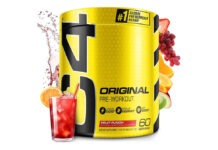Joe Dituri is no stranger to hyperbaric medicine. After 28 years in the U.S. Navy, the veteran received his Ph.D. in biomedical engineering with a focus on life support systems (hyperbarics included). He currently directs the Undersea Oxygen Clinic in Tampa. Now, he wants to use this technology to treat COVID-19 patients.
Hyperbaric chambers use controlled, high pressure gases in pressured steel or acrylic tubes commonly to treat divers and pilots suffering from pressure injuries (decompression sickness, a.k.a “the bends,” and air embolisms). Patients with these ailments cannot get enough oxygen to their body tissues.
“It operates in very much the same way for COVID-19 patients,” Dituri said. “COVID-19 patients cannot get enough oxygen into their lungs and bloodstream to give their cells enough to survive. COVID-19 also decreases red blood cells’ ability to carry oxygen, effectively starving body cells and consequently the rest of the body’s cells.”
This is where hyperbaric medicine comes in. Normal air is 21 percent oxygen. Because the air inside hyperbaric chambers is pressurized, the “oxygen molecules are compressed, squished” and the air inside the chamber holds more oxygen molecules than air outside, said Dituri. (The density of oxygen within the air inside the chamber is higher than atmospheric air outside the chamber.).
Therefore, with each breath, patients take in more oxygen molecules than they would breathing normally outside the tube. The settings can be controlled to provide patients with air that is the equivalent of 200% or 240% oxygen. Through simple physics, oxygen molecules are pushed into the patient’s body and carried to oxygen-starved tissues, Dituri said. This can support life when the lungs and circulation system otherwise could not supply enough oxygen to the body, said Dituri.
Hyperbaric oxygen therapy (HBOT), as the treatment is called, is also used to treat gangrene, carbon monoxide poisoning, bone infections and stubborn wounds, said Dituri. The medicine behind these treatments further explains why it could work for patients battling coronavirus, where lung tissues are compromised.
According to Dituri, HBOT promotes rapid healing of body tissues in the following ways:
- Boosts general immunity and reduces pain and swelling due to increased capillary growth and white blood cell activity.
- Increases production of special STEM cells by about 200% more than normal. These cells circulate in the body, salvaging and restoring damaged cells and tissues.
- Reduces diameter of blood vessels due to high concentration of oxygen. This can help slightly increase blood pressure, avoid massive swelling and prevent fluid leak from the blood into the lungs.
- Produces new blood vessels in damaged areas due to increased oxygen flow.
“The progress of COVID-19 is a systemic inflammatory response,” Dituri said. It chokes lung cells, then the body lacks oxygen and blood vessels dilate. “The body cues an immuno-response ‘red alert’ that makes you insane with inflammation and that can crash your blood pressure. Hyperbarics reduces inflammation, boosts immunity and helps produce more STEM cells to fix what’s broken.”
There is one caveat. “We can’t send someone with a crashing (blood pressure) into the chamber. We need to get them there much earlier, before the onset of real symptomatology, shortness of breath and wheezing, to try to prevent them from crashing,” Dituri said. “But, if seen in time at a hyperbaric facility, the hyperbarics can help the body help itself solve or ride out the disease.”
He shares a story of two patients who returned from Saudi Arabia with COVID symptoms but no diagnosis. Dituri had the patients treated with hyperbaric oxygen, and within a week’s treatment, both improved tremendously.
Dituri believes early treatment in patients with COVID-19 symptoms could prevent more people from reaching critical stages of the disease and overwhelming already-exhausted medical resources. Treatment could thwart the disease prior to the point where people need respirators and “reduce the need for machine- or ventilator-supported breathing by approximately half in those critically ill patients,” he said.
Unfortunately, for patients further along with the disease and on respirators, hyperbarics will not help until the recovery stage, said Dituri. He has been told that about 40% of patients on ventilators in intensive care units never come off of them. Those who do survive have scarred lung tissue from the extubation process as well as the virus itself and suffer reduced breathing capacity.
“On the backside, I think we can help patients who make it through as well,” Dituri said. “Hyperbarics can work to heal scar tissue in the lungs, decreasing healing time by up to 40%. Long term, it can help people get breathing again.”
The special STEM cells are the key. “They’re the golden ticket,” Dituri said. “They’re the building block of every single thing in your body along with collagen whose production is also stimulated by hyperbarics. The STEM cells can become any type of cell your body needs — liver, spleen or lung. They’re the best thing in the world.”
The main treatment risk with HBOT is central nervous system oxygen toxicity, where so much oxygen is absorbed by the body that the gas becomes toxic (around 300% oxygen). Dituri said, “The risk of this is very low. We back the pressure way down for coronavirus patients to around 160 percent, because fever can hasten CNS oxygen toxicity. This is the same amount of oxygen as a basic nitrox diver breathes at 1.6 pressure swimming around for 30 minutes.” He added, “We risk-mitigate and monitor patients carefully to watch for comorbidities and other complicating factors.”
To get access to hyperbaric treatment, a patient needs a referral by a doctor. Dituri knows three physicians on Telemed ready and willing to prescribe HBOT to COVID-19 patients. There’s just one problem — no patients.
“Hospitals aren’t letting (patients) go, because they say hyperbarics is not ‘standard of care’ for the disease,” he said. “But tell me, during a pandemic, what is the standard of care?”
Dituri is asking local hospital authorities to direct new COVID-19 cases to hyperbaric chambers for treatment.
Mariners Hospital in Tavernier, part of the Baptist Health South Florida network, has a hyperbaric chamber. Dr. Tom Morrison, who works in the emergency room at Mariners, said there is some conversation being had at the hospital about potential use of hyperbaric medicine to treat COVID-19 patients in the county.
He said, “There are some ongoing studies that Mariners was updated on. They’re drawing a kinship with carbon monoxide poisoning and think it might be working. I haven’t been involved on the E.R. side because they haven’t decided if it’s appropriate.”
Morrison added that he personally was still on the fence. He said, “Hyperbarics have some clinical applications, and it would be curious to see if it helps COVID-19 patients. I don’t know if it would help or not. I need to read up on it.”
Morrison, who has personally diagnosed eight to 10 COVID-19 positive patients in the community in the past two weeks and seen another 15 to 20 who never got tested, has additional concerns about being able to decontaminate the chamber, if used. He said, “I worry about decontaminating the room. It’s quite an elaborate process after a COVID-19 patient.”
At press time, The Weekly was waiting for further word from Baptist Health on their willingness to use hyperbaric medicine locally to treat COVID-19 patients. Morrison said, “I was told that Mariners is prepared to utilize our hyperbaric chamber if it’s shown to be useful and safe for our staff.”
Dituri said, “It’s killing me that we’re telling people with this virus to stay home until they’re really sick. If we get them in time, we can help them with hyperbarics. No question. There’s no double-blind, placebo-controlled study completed showing this works, but the physics holds true, and physics always works.”


























